
Do you have a question about the Eaton Cutler-Hammer DS-632 and is the answer not in the manual?
| Voltage Rating | 600V AC |
|---|---|
| Poles | 3 |
| Interrupting Rating | 18kA at 600V AC |
| Standard | UL, CSA |
| Trip Curve | Thermal-Magnetic |
| Standards | UL, CSA |
| Type | Molded Case Circuit Breaker (MCCB) |
Details on DS and DSL breakers, their construction, and major components.
Discusses specific differences and improvements in DS-206S and DS-416S models.
Details built-in interlocks and safety features designed to prevent hazards.
Lists critical practices for safe operation, maintenance, and handling of circuit breakers.
Procedures for receiving and handling breakers to prevent damage.
Guidelines for proper storage conditions to protect insulation.
Provides approximate weights for various breaker types and fuse trucks.
Describes the need to withdraw the breaker for examination and operation.
Instructions on preparing the compartment rails for breaker withdrawal.
Detailed steps for removing shipping braces before initial breaker withdrawal.
Procedures for lifting the breaker using appropriate adapters to prevent damage.
Guide to inspecting the breaker's major components before operation.
Overview of the breaker's main components and their functions.
Details on manual and power-operated breaker closing mechanisms.
Information on manual and electrical methods for tripping the circuit breaker.
Explanation of the levering device and breaker positions.
Covers trial mechanical operation and external examination of the breaker.
Detailed instructions for using the levering device to move the breaker.
Procedures for manually charging the breaker's closing springs.
Steps for closing and opening the breaker using its controls.
Covers placing breaker in test/connect/remove positions, final inspection.
Details on setting the Amptector trip unit for overload characteristics.
Final steps to place the breaker into operational service.
Overview of the breaker's operational principles.
Explains the spring-charged stored energy operating mechanism.
Details the motor-driven spring charging and closing system.
Illustrates the parts and operation of the power-operated spring charging.
Describes the manual spring charging and closing mechanism.
Details the manual spring charging mechanism components and operation.
Explains the mechanically trip-free closing mechanism and operational states.
Describes how the trip shaft rotation opens the breaker via various devices.
Covers interference interlocks, ground contact, motor cut-off switch, and seismic positioner.
Details on interlocking systems ensuring safe operation in different breaker positions.
In-depth explanation of the mechanical interlock system relating to breaker positions.
Explains the interlock that operates as the breaker moves out beyond TEST position.
Describes the interlock preventing manual closing of a breaker in the CONNECT position.
Details the electric lockout feature preventing closing of unenergized circuits.
Explains how the spring release latch is prevented when the breaker is already closed.
Details the padlock mechanism for securing the breaker in a trip-free condition.
Describes the construction of pole units for DS breakers.
Details the components of the moving contact assemblies for all ratings.
Details the stationary contacts, their pressure, and blow-on action.
Explains the function and design of arc chutes in extinguishing arcs.
Overview of sensors, Amptector trip units, and actuators for automatic tripping.
Details on the Amptector II-A solid-state trip unit and its settings.
Information on the Amptector I-A trip unit, including optional ground fault protection.
Details on setting up ground fault protection for the Amptector I-A trip unit.
Explains the discriminator circuit for fault current detection.
Guidelines for servicing the Amptector trip unit, emphasizing caution against tampering.
Describes the actuator that produces tripping force and the sensors detecting current.
Lists optional accessories providing additional protection and signaling functions.
Details the undervoltage trip device and its operation.
Describes the overcurrent trip switch for signaling breaker trips.
Explains the high load switch for advance overload condition notice.
Details the latch check switch ensuring proper breaker reset before closing.
Describes auxiliary switches for signaling breaker status.
Instructions for using the test kit to check Amptector trip unit operation and calibration.
General overview of DSL breakers, current limiters, and fuse trucks.
Information on DSL current limiter ratings and applications for extended interrupting ratings.
Visual indication for blown current limiters and breaker tripping function.
Details on DS-3200 and DS-4000 fuse trucks for mounting Class L fuses.
Procedures for installing fuse trucks in series with circuit breakers.
Instructions for replacing Class L current limiting fuses in fuse trucks.
Description of the blown fuse indicator and its operation on fuse trucks.
Describes fixed breaker features like padlock capability and key interlocks.
Explains the function of dummy elements and their key interlocking.
Guidelines for regular inspection, cleaning, and maintenance of circuit breakers.
Recommendations for the frequency of breaker inspections.
Details on what to inspect, including contacts, barriers, and arc chutes.
Specific inspection procedures for contacts in these breaker models.
Specific inspection procedures for contacts in DS-632 and DS-840 models.
Procedures for replacing moving and stationary contacts.
Guidelines for inspecting arc chutes for wear and damage.
Checking for missing parts, loose fasteners, and general wear.
Covers factory-set adjustments for trip latch, open stop, contacts, and levering mechanism.
Specifies lubrication points, frequency, and types of lubricants for maintenance.
Guidance on ordering and identifying replacement parts.
Information on identifying parts specific to DS-416S and DS-206S models.
Details on parts common to DS-416S and DS-420 breakers.
Details on parts common to DS-206S and DS-206 breakers.


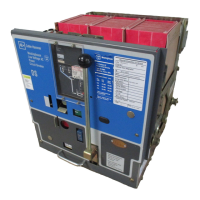

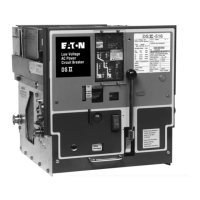
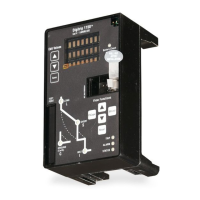
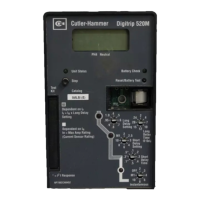

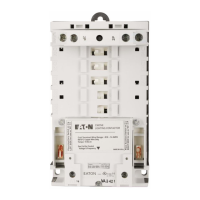



